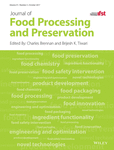Identification of Xiangzaolu Key Aroma Compounds and Stability Analysis of Microcapsule Production of Simulated Substance
Abstract
To improve the stability of xiangzaolu, the key aroma compounds were identified and microcapsules of a xiangzaolu-simulating substance were produced. Solid phase microextraction and simultaneous distillation and extraction combined with gas chromatography-olfactometry-mass spectrometry were applied to the flavor analysis of xiangzaolu, and the extraction effects of chromatographic columns of DB-WAX and DB-5 were compared. Nine key aroma compounds were identified by aroma extract dilution analysis with the flavor dilution factor ≥3, and they were subjected to further qualitative and quantitative analysis. Then, a xiangzaolu-simulating substance was prepared based on nine key aroma compounds by the detection of the concentration of xiangzaolu. Soy protein isolate and maltodextrin were used as wall materials, and monoglycerides and sucrose esters were used as emulsifiers. The optimized microcapsules were obtained by response surface optimization. pH 4.3 was the best condition for microcapsule production as determined by stability analysis after freeze-drying or spray-drying, including the determination of the zeta potential, turbidity and encapsulation efficiency, texture analysis, observation by scanning electron microscopy, and thermogravimetric analysis.
Practical Applications
There is much water in Xiangzaolu, and its fragrance is prone to fading due to its high concentration of alcohol. So it is very difficult to be stored and transported. Based on the seasoning function, microcapsule production of Xiangzaolu has less water and volume, which is fit for the modern fast-paced life style. Hence, it has great potential to achieve industry producing.




